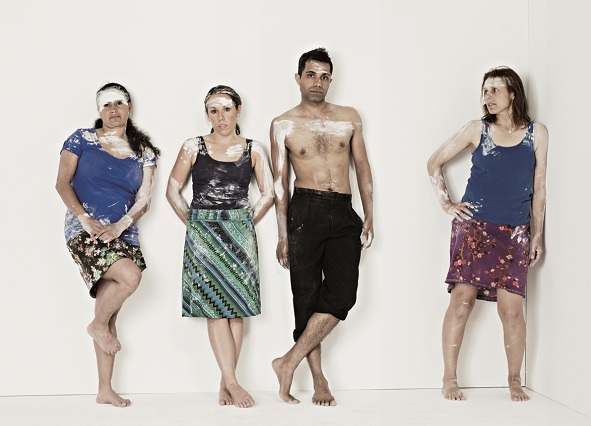Inspired by traditional painting, indigenous choreographer Vicki Van Hout brings ancient brush strokes to life in Briwyant.
By Paul Ransom.
Dance, like music, is universal; the language of the body in flow. From first nation societies to the gilded ballrooms of imperial Europe, dance performs a ceremonial, artistic and recreational function.
For Vicki Van Hout, a Wiradjuri woman from southern NSW and a contemporary choreographer working in the Western milieu, the arc of dance connects ancient and modern, city and country, tribal and theatrical. When her much lauded work Briwyant bursts onto the Merlyn stage at Melbourne’s Malthouse Theatre this month, opposite worlds will once again collide under the bright lights.
Like her more famous contemporary Stephen Page, Van Hout seeks to bring something of the indigenous dance vernacular into the geometric space of a modern theatre. “What I try to look for is the contemporary equivalent,” she declares, “and it’s not necessarily found within a black box.”
For Van Hout it is the act of dance itself that creates the connection. At its heart, she argues, there is something avowedly tribal about it. “It’s found at any sporting event; or at a rave. It’s at places where everybody has the one focal point, where energy is focused.”

Choreographer Vicki van Hout
By concentrating our focus, our energy, we are being taken beyond the merely passive role of audience and into something more gestalt like. “It’s the epitome of socialisation because there’s a kinda communication without words,” Van Hout elaborates. “It’s what I call community cultural dancing where you have this feeling that you’re connected to the other people around you. It’s not a religious experience but it’s about being a part of something else.”
In Briwyant the first connect point comes from the bir’yun effect in Yolngu painting, where colours and shapes appear to move. Vicki Van Hout was interested in translating paint to performance. “I realised that there was a direct correlation between the painting and the dance,” she says. “By looking at the painting you could see how you should hold your body in the dance.”
Anthropologists, indigenous historians and elders long ago recognised the patterns of interconnection between the various traditional artforms. “People take this stuff for granted; y’know, the paintings, the stories and the dance are all interconnected, la-la-la, but until somebody says something really specific it’s hearsay,” Van Hout contests.
Having initially been inspired to explore the connection whilst overseeing a class at Sydney University, Van Hout researched the symbolism of the shapes and lines in traditional indigenous painting. “What’s beautiful about being an urban indigenous person is that when I go to remote communities and get invited into their space to learn their stories I almost feel as if I’m making magic happen,” she expands. “But there’s not the dogma surrounding it because this is art.”
Beyond the simple choreographic representation of visual art motifs, Briwyant also delves into the spiritual story behind the various symbols. “And then it was about the ‘everywhen’,” Van Hout declares, “where time is not linear but the ‘then’ time and the ‘now’ time are at the same time. It then became this almost overwhelming thing, like I was going to dance the meaning of life or something.”
Briwyant has evolved away from the standard architectural prettiness of contemporary dance into something more deeply connected to country. “I suppose Briwyant refers to the significance of painting and the perpetuation of cultural practice,” Van Hout muses. “When they sing a painting, or dance it, they imbue it with more magic.”
However, on the differing intentions of contemporary and tribal dance, she remains clear. “When I’m doing contemporary dance I’m performing for people. It’s about the outside. When I do this, I look like that. This one is more life affirming, more about the inside.”
Vicki Van Hout is obviously used to dancing in a space occupied by two cultures, having studied at both NAISDA (National Aboriginal Islander Dance Academy) and the legendary Martha Graham School in New York. “I don’t know the meaning of life,” she freely admits, “but what I like to do with the dance, even though it sounds so simplistic, is to say, ‘look, we’re not so different’.”
Nonetheless, challenges remain. Whereas many would ‘appreciate’ indigenous artforms as part of an attitude that says ‘aboriginal culture deserves respect’, there is often a gap in genuine critical appreciation. For a dance maker like Vicki Van Hout it comes down to a simple question, “How can I make people appreciate indigenous contemporary dance the way they appreciate, say, classical ballet?”
The answer perhaps is to keep creating brilliant new works like Briwyant.
Briwyant
July 4-15
Merlyn Theatre at Malthouse Theatre, Southbank Melbourne
www.malthousetheatre.com.au
August 1-4
Brisbane Powerhouse, New Farm, Brisbane
www.brisbanepowerhouse.org
Photos: Henrietta Baird, Mel Tyquin, Raghav Handa & Vicki Van Hout in Briwyant. Photo by Garth Oriander


















Pingback: Briwyant by Vicki Van Hout | Dance Informa Magazine